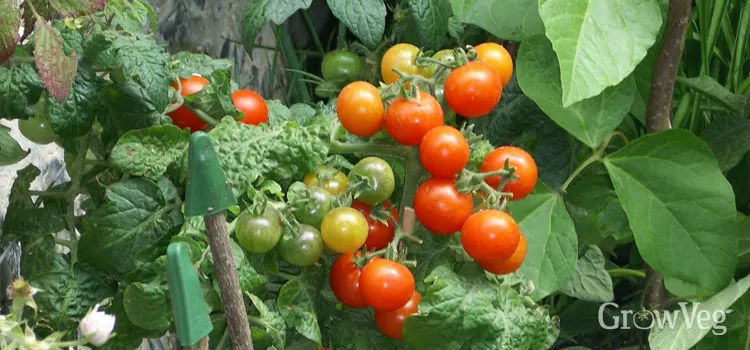Why are my tomatoes flowering but not fruiting?

Are you harvesting a lot of tomatoes this season? If not, take consolation in the knowledge that you are not alone. A lack of fruit set – when flowers fail to produce fruits before they wither and drop – is one of the most common complaints among tomato growers. It’s infuriating and unfair, especially considering all the care you’ve undoubtedly given your plants to bring them this far.
Whether you’re yet to pick a solitary tomato, or your plants have abruptly stopped producing, the reasons behind the lack of fruit are often predictable and easy enough to fix. But don’t give up – keep reading to discover whether your plants may be convinced to behave.

Contents
1. Insufficient Pollination
The first thing to examine is how easily pollinating insects can get to your crops. Tomato flowers are self-fertile, which means they can pollinate themselves. Nevertheless, the presence of bees and/or wind dramatically improves pollination by nudging the flowers just enough to help dislodge the pollen from the stamens.
Bumblebees are very adept at this. As they contract their flight muscles (a process called ‘buzz pollination’) these low vibrations literally shake the pollen free, allowing it to drop down onto the stigma – the female part of the flower that catches the pollen.
If you produce tomatoes in a greenhouse or polythene tunnel, you should think about whether pollinating insects have easy access to the plants. Open up doors and vents, which will also help to create a good through-flow of air, keeping plants cooler and reducing the risk of disease.
You can artificially pollinate tomatoes by lightly shaking the plants yourself to mimic the bee’s buzz. Twang string-lines or canes that support vining tomatoes, or gently lift and drop container tomatoes (from a very short distance!).

2. High Heat Levels
High temperatures may occasionally disrupt pollination in hotter areas. Hot periods, in which daytime temperatures persist over 30oC (86oF) and nighttime temperatures do not fall below 24oC (75oF), have the unfavorable consequence of rendering pollen infertile. Tomatoes, it turns out, prefer it hot – but not too hot!
During a heat wave, the only thing you can do is wait. In the meantime keep plants well watered and healthy, so that when temperatures finally subside they’ll be in an excellent position to ramp up production once more.
Remember that various tomato types thrive in different climates. If you’re in a hot part of the world, grow a heat-tolerant variety that is recommended for your region.
A further difficulty is the absence of humidity. Very high humidity can clog the pollen, so it’s unable to drop, while in very dry climates flowers may become so parched that pollen fails to stick and simply rolls straight off. Regular watering may assist to elevate the humidity surrounding the plants just enough to improve circumstances in this case.

3. Not Enough Fertilizer (or the Wrong Type)
The last consideration is soil fertility. Are your tomato plants receiving enough nutrients to produce large, flavorful fruits? Even if you have rich soil, you should start feeding your tomatoes with an organic fertilizer strong in potassium, or potash, as soon as the first blossoms develop. Potassium promotes flower initiation and, as a result, fruit yield.
Keep tomatoes fed with an off-the-shelf tomato fertilizer or make your own high-potash liquid fertilizer for free. Every garden should contain a clump of comfrey for making homemade fertilizer.
Once you’ve done all you can to improve conditions, you’ll just have to be patient and wait for Mother Nature to do the rest. Don’t give up hope because things will get better. When that happens, the tomatoes will come thick and fast, leaving you wondering what to do with them all!
Related Questions
-
Why would a tomato plant flower but not produce tomatoes?
It’s not getting nearly enough light.
Tomato plants need at least 6-8 hours of direct sunlight. Without the proper energy, you’ll be left with a lot of blooms and little fruit. -
Why are my tomatoes blooming but not setting fruit?
Exposure to unfavorable weather conditions is the primary cause of tomato plants dropping their blooms and failing to produce fruit. The optimum daytime growing temperatures for tomatoes are between 21-30°C (70-85°F).
-
How do you encourage tomatoes to fruit?
Are your tomato plants receiving enough nutrients to produce large, flavorful fruits? Even if you have rich soil, you should start feeding your tomatoes with an organic fertilizer strong in potassium, or potash, as soon as the first blossoms develop. Potassium promotes flower initiation and, as a result, fruit yield.
-
Why are my tomatoes all leaves and no fruit?
#1 – Too Much Nitrogen
Although abundant nitrogen produces attractive green leaves, it does nothing to encourage blooming.” Tomatoes are heavy feeders that need nitrogen, phosphorous, potassium, and a variety of micronutrients. They need less nitrogen and more phosphorus to develop blooms.





